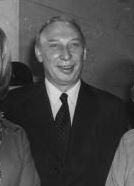
Hatfield is a town and civil parish in Hertfordshire, England, in the borough of Welwyn Hatfield. It had a population of 29,616 in 2001, and 39,201 at the 2011 Census. The settlement is of Saxon origin. Hatfield House, home of the Marquess of Salisbury, forms the nucleus of the old town. From the 1930s when de Havilland opened a factory until the 1990s when British Aerospace closed it, aircraft design and manufacture employed more people there than any other industry. Hatfield was one of the post-war New Towns built around London and has much modernist architecture from the period. The University of Hertfordshire is based there.

The de Havilland Aircraft Company Limited was a British aviation manufacturer established in late 1920 by Geoffrey de Havilland at Stag Lane Aerodrome Edgware on the outskirts of north London. Operations were later moved to Hatfield in Hertfordshire.

Captain Sir Geoffrey de Havilland, was an English aviation pioneer and aerospace engineer. The aircraft company he founded produced the Mosquito, which has been considered the most versatile warplane ever built, and his Comet was the first jet airliner to go into production.

Hawker Siddeley was a group of British manufacturing companies engaged in aircraft production. Hawker Siddeley combined the legacies of several British aircraft manufacturers, emerging through a series of mergers and acquisitions as one of only two such major British companies in the 1960s. In 1977, Hawker Siddeley became a founding component of the nationalised British Aerospace (BAe). Hawker Siddeley also operated in other industrial markets, such as locomotive building and diesel engine manufacture. The company was once a constituent of the FTSE 100 Index.

The University of Hertfordshire (UH) is a public university in Hertfordshire, United Kingdom. The university is based largely in Hatfield, Hertfordshire. Its antecedent institution, Hatfield Technical College, was founded in 1948 and was identified as one of 25 Colleges of Technology in the United Kingdom in 1959. In 1992, Hatfield Polytechnic was granted university status by the British government and subsequently renamed University of Hertfordshire. It is one of the post-1992 universities.

The British Aerospace 125 is a twinjet mid-size business jet. Originally developed by de Havilland and initially designated as the DH.125 Jet Dragon, it entered production as the Hawker Siddeley HS.125, which was the designation used until 1977. Later on, more recent variants of the type were marketed as the Hawker 800.
Airbus UK is a wholly owned subsidiary of Airbus which produces wings for Airbus aircraft. When Airbus was incorporated as a joint-stock company in 2001, BAE Systems transferred its UK Airbus facilities in return for a 20% share of the new company. These facilities became Airbus UK. The company has two main sites responsible for the design and manufacture of the high-technology wings for all Airbus models as well as overall design and supply of the fuel system. For most Airbus models, the company is responsible for overall design and supply of landing gear. The company employs around 13,000 people at two sites: Filton, where the engineering and design activity takes place along with some manufacturing, and Broughton, where other major wing component manufacturing and all wing assembly takes place.

The Fleet Air Arm Museum is devoted to the history of British naval aviation. It has an extensive collection of military and civilian aircraft, aero engines, models of aircraft and Royal Navy ships, and paintings and drawings related to naval aviation. It is located on RNAS Yeovilton airfield, and the museum has viewing areas where visitors can watch military aircraft take off and land. At the entrance to the museum are anchors from HMS Ark Royal and HMS Eagle, fleet carriers which served the Royal Navy until the 1970s. It is located 7 miles (11 km) north of Yeovil, and 40 miles (64 km) south of Bristol.

Geoffrey Raoul de Havilland Jr., OBE was a British test pilot. He was the son of Geoffrey de Havilland, the English aviation pioneer and aircraft designer.
Stag Lane Aerodrome was a private aerodrome between 1915 and 1933 in Edgware, north London, UK.

The Hawker Siddeley HS-121 Trident is a British airliner produced by Hawker Siddeley. In 1957, de Havilland proposed its DH.121 trijet design to a British European Airways (BEA) request. By 1960, de Havilland had been acquired by Hawker Siddeley. The Trident's maiden flight happened on 9 January 1962, and it was introduced on 1 April 1964, two months after its main competitor, the Boeing 727. By the end of the programme in 1978, 117 Tridents had been produced, and the Trident was withdrawn from service in 1995.

The Gatwick Aviation Museum is located in the village of Charlwood, in Surrey, United Kingdom on the boundary of Gatwick Airport.
Hatfield Aerodrome was a private airfield and aircraft factory located in the English town of Hatfield in Hertfordshire from 1930 until its closure and redevelopment in the 1990s.

Dunsfold Aerodrome is an unlicensed airfield in Surrey, England, near the village of Cranleigh. It extends across land in the villages of Dunsfold and Alfold.

Sir Arnold Alexander Hall FRS FRAeS was an English aeronautical engineer, scientist and industrialist.
Ralph Spenser Hooper OBE FREng FRAeS is an English aeronautical engineer, recognised mostly for his work on the Hawker Siddeley Harrier, specifically in relation to the marriage between the Pegasus engine and the layout of the aircraft, allowing it to safely hover with margins of stability.
Leavesden is a residential and commercial area in the northern part of Watford, England. It lies within the M25 Motorway. On its eastern side it is bounded by the M1 Motorway. Leavesden is split into two councils which are Watford Borough Council and Three Rivers District Council. Leavesden Green is an adjoining residential community which lies partly in Three Rivers and partly in the Borough of Watford.
William Patrick Ingram Fillingham was an English test pilot for the de Havilland company. Fillingham flew 120 different types of aircraft during his career including all variants of the de Havilland Mosquito.
John Wimpenny was an English aeronautical engineer who held the record for the longest human powered flight.
Ralph Marcus Hare (1914-2009) was a British aircraft engineer. He was a longtime engineer at the aviation firm de Havilland and worked on the production and development of the de Havilland Mosquito.













